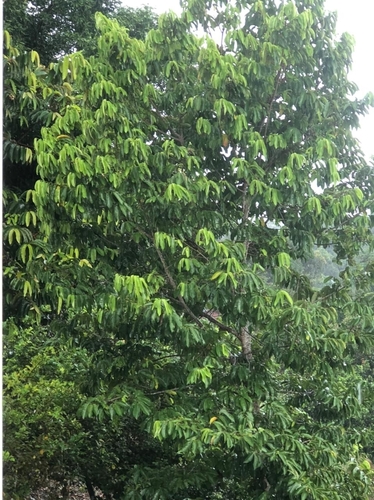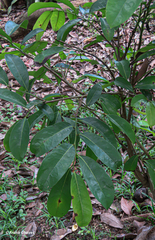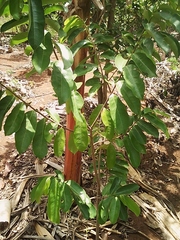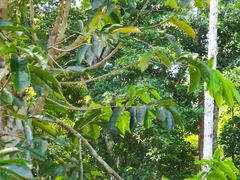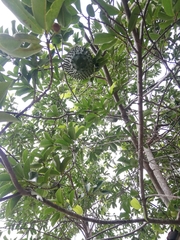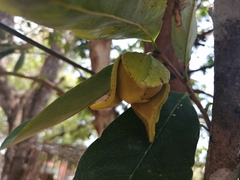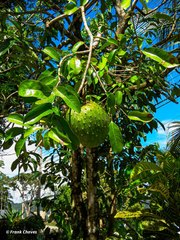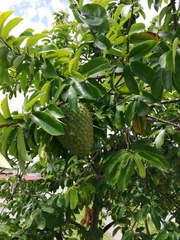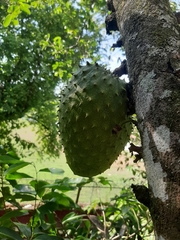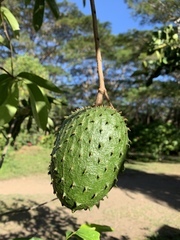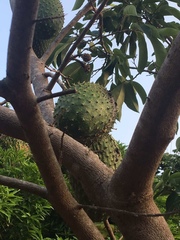

|
|
|
|
Family: Annonaceae
Soursop, more... (es: Guanábana)
|
Descripción: Árbol de 5 a 12 m de alto. Copa piramidal y con follaje lustroso. Tronco ramificado a baja altura. Corteza exterior negra o gris. Ramitas terminales con lenticelas blancas y pelos de color marrón castaño. Hojas simples y alternas, de 4-15 x 3-6 cm, oblongas a obovadas, con ápice obtuso o agudo, bordes enteros y base decurrente o redondeada. Pecíolo de 0.3-0.6 cm de largo y acanalado en la parte superior. Flores amarillas o cremas, caulinares, saliendo de las ramas o del tronco. Frutos oblongos a ovoides, de 15-30 x 10-15 cm, verdes y con proyecciones espinosas arqueadas sobre la superficie exterior. Semillas envueltas en una pulpa blanca. Datos Ecológicos: La especie crece a bajas elevaciones, en lugares secos o húmedos. Común como planta cultivada en todo el país. Florece y fructifica durante todo el año, principalmente de mayo a octubre. Especies Parecidas: A menudo se confunde con LK annomo Annona montana LK2 , pero en A. montana los frutos son globosos y de menor tamaño. Usos: La pulpa de los frutos maduros es comestible, también se usa para preparar jugos, batidos y helados. Las hojas se utilizan para fabricar un té medicinal, empleado para combatir malestares estomacales y la diarrea. La cocción de las hojas se aplica sobre el cabello para matar los piojos. Tree, to 7 m tall; young stems and sometimes petioles ferruginous-tomentose. Petioles ca 5 mm long; blades oblong-elliptic to oblong-obovate, acuminate, obtuse to rounded at base, 6-12 cm long, 2.5-5 cm wide, glabrous. Flowers solitary along stems; pedicels 2-3 cm long; sepals 3, ovate, less than 5 mm long; petals valvate, the outer 3 ovate, free, thick, 2-3 cm long, the inner 3 thinner and smaller than the outer; stamens numerous. Fruits fleshy aggregates, ovoid-ellipsoid, to 20 (25) cm long and 10 (12) cm diam, with white juicy pulp, dark green, bearing stout fleshy spines; seeds numerous, l per carpet. Croat 5176, 5898. Cultivated at the Laboratory Clearing near the dock. Flowers from January to August. The fruits, which hang on all year, are known to mature in July and August, but probably in the dry season also. Bocas Species Database Habitat: Annona muricata will be usually found in lowlands, between sea level and 1200 m of altitude. It is fairly tolerant in poor soil but cannot stand frost. It is a common cultivated plant in Panama. Distribution: This tree species has been reported from the West Indies and from southern Mexico to Peru and Argentina. It has also been spread from southeastern China to Australia and the lowlands of eastern and western Africa. Natural History Notes: The Annona muricata is originated from tropical America. It is cultivated for the fruit but also for the roots and the leaves that are used for medicinal purposes. Different hybrids have been created to provide more varieties of soursop on the market. Soursop can be used in juices, ice creams and popsicles, and can also be made into a delicious custard often eaten with sugar and milk. Different parts of the tree are used and processed to prepare natural medicinal products. Here is a series of examples. A decoction made of ground seeds and leaves can serve as a natural pesticide. The leaves can also been mashed and can alleviate eczema and other skin problems and rheumatisms. The roots of the trees are used as a vermifuge and the root bark serves as an antidote for poisoning. However, the juice from the seeds does not have all those positive uses. The juice is in fact poisonous and irritating. Characteristics: The Soursop tree usually reaches a height between 7.5 and 9 m. The branches organization gives it a bushy appearance. It is an evergreen tree. The leaves have an oval to elliptical and pointed shape; they have a smooth texture and a dark green coloration. The part below the leaf is usually lighter than the top part. The flower can emerge from any part of the trunk, the branches or the twigs. The flower has a cone shape and is yellow-green on the outside and more yellow on the inside. The tree will depend on cross pollination for the production of the fruit. The fruit soursop is easily recognized by its oval shape and by the leather-like shaped skin that is covered with many spikes. The immature fruit will have a dark-green skin and as it comes to maturity, the fruit will be softer and will have a yellowish-green coloration. The inside of the fruit contains the white flesh and several seeds. A large fruit can contain from 12 to 200 or more seeds! The white flesh is the edible part. It has a fibrous and juicy texture, a sweat smell and an acidic taste. |

